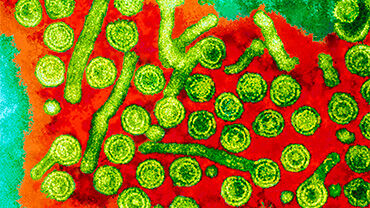World Hepatitis Day 2023: need to scale up efforts to address hepatitis B and C
World Hepatitis Day is marked on 28 July each year to increase the awareness and understanding of viral hepatitis.
Worldwide, hepatitis B and hepatitis C cause 1.1 million deaths and 3 million new infections every year combined, while in the EU/EEA there are approximately 6 million people living with chronic hepatitis B and C infection.
Current evidence suggests that for the EU/EEA there has been a steady decline in the reported number of new transmissions of hepatitis B in all countries due to the effective implementation of hepatitis B vaccination.
For hepatitis C, some countries have also reported a decline in the number of new transmissions due to the impact of primary prevention measures. However, this is not the case for some key populations such as people who inject drugs, who are disproportionately affected by hepatitis C and who often face barriers and gaps in services that need to be addressed.
Andrea Ammon, ECDC Director, said
“The impact of effective prevention measures, such as hepatitis B vaccination, have led to a reduction in disease transmission related to hepatitis B and C over the years. However, the burden of chronic hepatitis B and C infections in the EU/EEA remains considerable, as a large proportion of people living with the disease remain undiagnosed and, as a result, do not receive the treatment and care that they need. To address these issues, we need to urgently scale up our efforts to strengthen and introduce new innovative approaches for diagnosis and treatment”.
The European Centre for Disease Prevention and Control (ECDC) has developed a monitoring system that collects data to assess progress in EU/EEA countries towards the hepatitis elimination targets outlined in the World Health Organization (WHO) European Action Plan for hepatitis.
ECDC’s 2021 data suggests significant gaps in Hepatitis B and C diagnosis and treatment, nevertheless, There is concerning evidence that some people are diagnosed too late and already have cirrhosis or hepatocellular carcinoma at the time of their diagnosis.
ECDC also published at the end of 2022 a report on progress towards the elimination targets related to the prevention of hepatitis which highlighted that for some of the targets countries are far from reaching the 2020 WHO European Action Plan targets for hepatitis. Overall, the data up to 2022 indicate that there is still considerable work to be done to reach the goals of eliminating viral hepatitis by 2030 and strengthening hepatitis prevention and control programmes.
To eliminate viral hepatitis by 2030, essential steps must be taken:
- Countries need to identify those who might be unknowingly infected with viral hepatitis through more testing.
- It is especially important that those most at risk for hepatitis have easy access to testing, for example, men who have sex with men or people who inject drugs. Individuals diagnosed with an infection should also have access to care.
- Treatment programmes across Europe and coverage of prevention and control practices need to be scaled up to interrupt existing transmission chains and to reduce associated morbidity and mortality.
- Countries should continue to improve their information systems to understand the national burden of viral hepatitis and be able to monitor progress towards the elimination target.
Global situation
The WHO has developed global health sector strategies on HIV, viral hepatitis, and sexually transmitted infections for the period 2022-2030 with the goal of ending AIDS, viral hepatitis B and C and sexually transmitted infections by 2030. These strategies recommend integrated and disease-specific local actions supported by actions from the WHO and partner organisations. The strategies emphasise the need for actions to focus on people most affected and at risk for each disease that addresses inequities.
The aim of World Hepatitis Day marked on 28 July each year, is to increase the awareness and understanding of viral hepatitis and the five known hepatitis viruses, referred to as types A, B, C, D and E.
Links
- We’re not waiting’ is the campaign of the World Hepatitis Alliance for WHD 2023.
- Global progress report on HIV, viral hepatitis and sexually transmitted infections, 2021 (WHO)
- Elimination barometer on viral hepatitis among people who inject drugs in Europe (EMCDDA)
- ECDC expert Erika Duffell speaks to the BMJ Podcast to discuss the importance of scaling up diagnostic testing for hepatitis B (BMJ)
- Estimates of hepatitis B virus prevalence among general population and key risk groups in EU/EEA/UK countries: a systematic review (Eurosurveillance)







